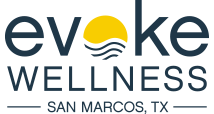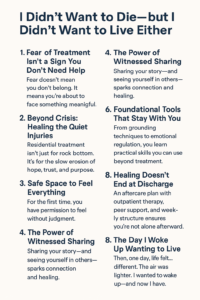I Didn’t Want to Die—but I Didn’t Want to Live Either
That gray space between wanting to end the pain and not wanting to hurt anyone with your absence is a lonely place. I lived in that shadow for months. Outwardly, I was fine—job intact, family intact—but inside, everything felt numb. I wasn’t planning to die. I just didn’t want to be anymore.
When someone suggested a residential treatment program, alarm bells went off. “That’s too extreme. I’m not suicidal enough.” I thought it meant hospitals, locked doors—maybe even shame. But it turned into a turning point. I showed up afraid. I left wanting to live.
1. Fear of Treatment Isn’t a Sign You Don’t Need Help
My first thought: “If I’m scared to go, it means I don’t belong.”
But I learned something vital—fear is not a barometer of need. It’s a signal that you’re about to face something meaningful. Evoke Wellness TX doesn’t require perfection. They ask only for openness. You don’t have to be broken to deserve help. You just have to be hurting.
2. Beyond Crisis: Healing the Quiet Injuries
Residential treatment isn’t just for when you’ve hit rock bottom. Sometimes the damage is slow. The nights are harder than the mornings. The heartache isn’t dramatic—it’s quiet and persistent. That’s what got me: a slow erosion of hope, trust, purpose.
Inside that residential space, I began to address the quiet injuries—unresolved grief from years ago, shame I’d tucked away, resentments I couldn’t let go. When those parts were named, they started to lose power. And when they lost power, space opened. Space to breathe. Space to hope.
3. Safe Space to Feel Everything
You never get to this place by avoiding feelings. Avoiding them created this place. I was numb because I was afraid. Afraid of the tears. Afraid of the embarrassment. Afraid of falling apart and never stopping.
Residential care gave me something I never had before: permission to feel. No need to mask. No need to hold it together. You’re surrounded by people whose job is to help you feel—to guide you, sit with you, reflect back your pain without judgment. It’s like someone finally saying, “It’s okay to not be okay,” and meaning it with their whole being.
4. The Power of Witnessed Sharing
When I first shared my story, it came out in fragments. I didn’t trust my words. Then someone else shared—and I thought, “That’s me. That’s me.”
Connection changed everything. It wasn’t about outperforming each other. It was about being seen. Being heard. Being human. Residential Treatment in Texas is like a circle of mirrors: you see yourself reflected, and you see pieces you’ve forgotten. In that reflection, you begin to believe healing is real.
5. Foundational Tools That Stay With You
One day, I was in a session on grounding techniques. I learned to breathe, to tune into my environment, to touch something solid when panic rose. I kept thinking it was kindergarten-level—but months later, in a real anxiety attack, I used it. It worked.
I also learned ways to regulate emotions, track triggers, build a safety plan. These were not theoretical. They were practical, held in the structure of a house where everyone commits to being present. Tools became habits. Habits became lifelines.
6. Routine Is Not Restriction—It’s a Framework for Hope
The schedule in residential care surprised me. Not like boot camp, but more like a nurturing rhythm. Breakfast. Group. Journaling. Therapy. Movement. Reflection. Repeat.
I thought routine would feel oppressive. Instead, it felt secure. I didn’t need to decide what came next or argue with myself about doing it. Just follow the rhythm, come to feel stable—and slowly, the rhythm started to matter to me. It became something I would trade a broken morning for.
7. Healing Doesn’t End at Discharge
People fear residential treatment is a cocoon—and once you leave, you’ll fall apart. I felt it. But no—they don’t send you out unprepared.
Evoke Wellness TX created an aftercare plan with me. It had outpatient therapy, peer support connections, crisis tools, and weekly structure. They matched me with a recovery specialist I could message when the quiet doubt crept back. They didn’t say “good luck.” They said, “Let’s plan for what comes next.”
That planning made the next steps feel possible—not terrifying.
8. The Day I Woke Up Wanting to Live
There was a morning—I remember it. I woke up and the air felt different. The room felt different. I didn’t dread the day. I wanted to wake up. My brain didn’t feel like static anymore. It felt like windows opening.
That morning isn’t timeless. I still have dark nights. But now when the darkness comes, I’ve got a memory—and I’ve got tools—to help me find the light again.
A Metaphor That Saved Me
Think of treatment like a greenhouse for a wounded plant. Outside, the weather is unpredictable. There are pests. The soil might be poor. In the greenhouse, you’ve got time, care, tools, a structured environment. The plant lies down for a moment—its leaves may crumble—but then, with regular light and water, it begins to root deeper, grow stronger. Then the gardener moves it out, and it thrives—not because the greenhouse makes you fragile, but because it helped you rebuild.
A Gentle Reminder: You Didn’t Cause This Alone—and You Don’t Have to Heal Alone
That feeling of isolation—believing you’re the only one living inside a pain no one else sees—breaks something essential. Residential treatment doesn’t erase your story. It honors it. It says: Your pain deserves space. Your life deserves care. Your healing matters.
If you’re reading this, and you think: “That was me,” or “I’m close,” reach out. You don’t have to stay in that gray space. You deserve mornings you want to wake up for. Call (888) 450‑2285 to learn how our residential treatment program services in San Marcos, Texas, can help you wake up wanting to live again.
Frequently Asked Questions (FAQs)
Q: I’m afraid residential treatment will isolate me from life.
A: It can feel that way, but it’s a temporary pause—a chance to recalibrate. Evoke Wellness uses structure, but also connection: calls home, personalized follow-ups, and a team that ensures you’re never alone.
Q: What happens if I’ve tried other treatment before?
A: That makes you a stronger candidate. People who’ve done outpatient and still feel stuck are often the ideal candidates for residential care. You’ve done the groundwork. Now it’s time for deeper work.
Q: How long do I stay?
A: It varies. You and your care team decide based on need. Some stay a few weeks; others a couple of months. The goal isn’t time—it’s readiness to return, equipped and steady.
Q: Is it a hospital or punitive environment?
A: Not at all. Residential treatment at Evoke Wellness TX is caring—not clinical, supportive—not punitive. The goal is wellness, not surveillance.
Q: Will I feel worse before I feel better?
A: Possibly. Sometimes you’ll revisit painful emotions you’ve held down. But you won’t do it alone. Therapists, peers, crew: they hold you, support you, guide you. And usually, your lowest moment becomes the launchpad.
Q: What if I relapse during or after residential treatment?
A: Relapse is part of many healing stories. If it happens, the team helps you reset. They help you rebuild—not tell you you failed. It’s about resilience, not perfection.



